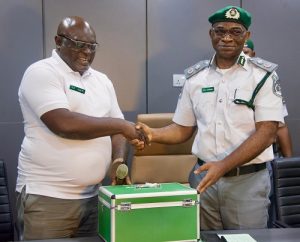Pilot Error Caused Dramatic F-35C Crash in S. China Sea

(TME) A simple pilot error caused the well-publicized crash of a U.S. Navy stealth fighter aboard a carrier in the South China Sea in 2022, according to the results of an official investigation.
On January 24, 2022, the pilot of an F-35C was coming in for a landing aboard the carrier USS Carl Vinson. He requested permission to use a rapid landing maneuver called a “Sierra Hotel Break,” in which the fighter makes two tight turns on approach in order to lose speed and get on board faster.
This is an “approved and common maneuver,” but the pilot – a junior officer on his first tour – had never done it before. He took the first turn at an “excessive” 7 Gs, tightening the turn circle, reducing the distance traveled and compressing the timeline for the expedited landing approach. In the rush, he forgot to complete his landing checklist, and he did not hit the switch to transition from full-manual into an optional landing-assist mode that automatically handles engine power.
The pilot pulled back the throttle to bare idle and activated his speed brake in order to slow the aircraft. As he closed in on the final landing, the F-35C’s engines were still at idle, the brake was still deployed and the plane was coming in too low. The pilot believed that the fighter’s landing-assist mode was engaged and operating the throttle when in fact he was still in full manual control. He realized the risk just a few seconds before impact, but at that point it was too late to avert a crash.
The jet hit the ramp at the stern and the landing gear collapsed on impact. It snagged on the first and second arresting wires, and a catch on the wing put the plane spinning across the deck. The pilot ejected as it spun, successfully escaping the cockpit before the plane slid off the port side. Five members of the ship’s crew who were standing nearby were injured by flying debris, and the pilot was injured by the ejection. Three, including the pilot, had to be medevaced for treatment.
The loss of the jet came to $115 million, plus the costs of salvaging its secret components from the seabed. Scrape damage to the carrier’s deck and debris impact to one EA-18 Growler added to the cost.
If the F-35 had not caught the arresting wires, its momentum could have carried it in a straight line towards the bow, where there were parked aircraft and personnel at work, the investigators noted.
In response, U.S. Pacific Fleet has made the landing-assist mode mandatory for all F-35C pilots on carrier approach, and it has asked for Lockheed to add a heads-up indicator to alert the pilot if the mode is not engaged when it should be.
The investigators found that there was nothing wrong with the pilot or his qualifications, nor with the plane. Up until the crash, “his landing performance on the ship had been exceptional.” He remains in the Navy but is no longer flying.
Leaked photos and videos of the crash emerged on social media shortly after the accident, and the Navy has confirmed the imagery’s authenticity. Four enlisted crewmembers of the Vinson have been reprimanded in connection with the unauthorized leaks, according to the Navy.
*Culled from The Maritime Executive
On January 24, 2022, the pilot of an F-35C was coming in for a landing aboard the carrier USS Carl Vinson. He requested permission to use a rapid landing maneuver called a “Sierra Hotel Break,” in which the fighter makes two tight turns on approach in order to lose speed and get on board faster.
This is an “approved and common maneuver,” but the pilot – a junior officer on his first tour – had never done it before. He took the first turn at an “excessive” 7 Gs, tightening the turn circle, reducing the distance traveled and compressing the timeline for the expedited landing approach. In the rush, he forgot to complete his landing checklist, and he did not hit the switch to transition from full-manual into an optional landing-assist mode that automatically handles engine power.
The pilot pulled back the throttle to bare idle and activated his speed brake in order to slow the aircraft. As he closed in on the final landing, the F-35C’s engines were still at idle, the brake was still deployed and the plane was coming in too low. The pilot believed that the fighter’s landing-assist mode was engaged and operating the throttle when in fact he was still in full manual control. He realized the risk just a few seconds before impact, but at that point it was too late to avert a crash.
The jet hit the ramp at the stern and the landing gear collapsed on impact. It snagged on the first and second arresting wires, and a catch on the wing put the plane spinning across the deck. The pilot ejected as it spun, successfully escaping the cockpit before the plane slid off the port side. Five members of the ship’s crew who were standing nearby were injured by flying debris, and the pilot was injured by the ejection. Three, including the pilot, had to be medevaced for treatment.
The loss of the jet came to $115 million, plus the costs of salvaging its secret components from the seabed. Scrape damage to the carrier’s deck and debris impact to one EA-18 Growler added to the cost.
If the F-35 had not caught the arresting wires, its momentum could have carried it in a straight line towards the bow, where there were parked aircraft and personnel at work, the investigators noted.
In response, U.S. Pacific Fleet has made the landing-assist mode mandatory for all F-35C pilots on carrier approach, and it has asked for Lockheed to add a heads-up indicator to alert the pilot if the mode is not engaged when it should be.
The investigators found that there was nothing wrong with the pilot or his qualifications, nor with the plane. Up until the crash, “his landing performance on the ship had been exceptional.” He remains in the Navy but is no longer flying.
Leaked photos and videos of the crash emerged on social media shortly after the accident, and the Navy has confirmed the imagery’s authenticity. Four enlisted crewmembers of the Vinson have been reprimanded in connection with the unauthorized leaks, according to the Navy.
*Culled from The Maritime Executive





